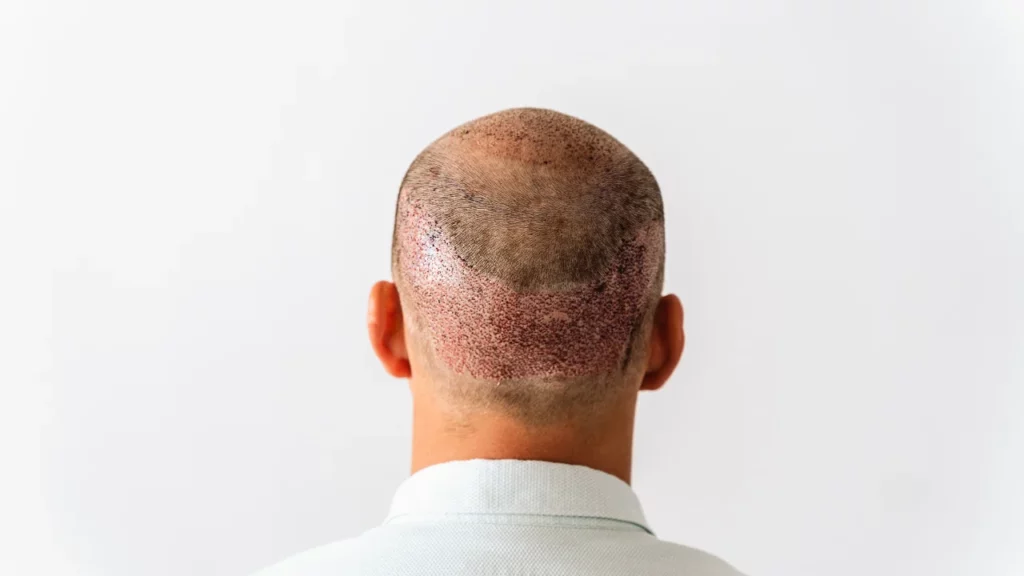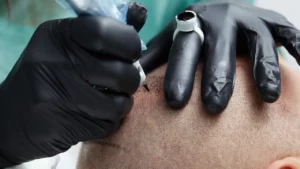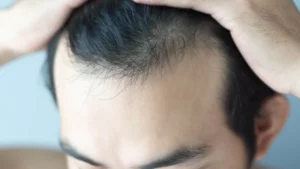After hair transplant surgery, the recovery process is completed by going through certain stages. These stages are referred as the hair transplant growth timeline. Each stage has its own unique characteristics. It is necessary to support the stages with correct recovery steps.

You need to be careful during the hair transplant after surgery phases. You must strictly comply with your doctor’s recommendations. You should not neglect the care procedures required for your hair. Thus, you can complete the healing process correctly and quickly.
Hair Transplant Growth Timeline: Stage by Stage
Hair transplant growth timeline is divided into certain stages. Initially, the healing process takes between 1-14 days. Afterwards, a process continues until the 12th week. Starting from the 3rd month, the hair begins to grow rapidly and the process ends in the 18th month.
Each process contains its own unique dynamics. The most important turning point in the hair transplant growth timeline is after the second week. 2 weeks after hair transplant is the gradual growth phase. The period called shock loss occurs during this period.
Hair growth begins to accelerate within 4-6 months. There is a significant improvement in hair density. Afterwards, it is necessary to wait until the 12th month. Natural results are observed starting from the 12th month and the process is completed in the 18th month.
How Long Does Recovery Take After Hair Transplant?
Hair transplant growth timeline can give you certain information about post hair transplant. Afterwards, all the details vary from person to person. Because it is necessary to look some details such as the person’s health condition and the presence of additional treatments.
- After Surgery: Most patients do not need to wait in the clinic after hair transplant. Itching, numbness and mild pain may occur within 1-2 days after the treatment. These are a natural part of the hair transplant recovery process.
- First Week: Stitches after hair transplant are removed within 7-10 days. 10 days after hair transplant is a small milestone. Because the person can slowly start to return to normal life. Hair can be washed as the way recommended by the doctor.
- Three Weeks: It is another milestone in the hair transplant growth timeline. All strenuous activities should be avoided for the first three weeks. After the three-week period is completed, you can move without having to avoid strenuous activities.
- Six Weeks: This is the halfway point in terms of hair transplant recovery timeline. Newly growing hairs start to fall out and this is a normal situation. Hair shedding is necessary for healthy hair to start growing smoothly.
- Three Months: After the hair falls out, a period of five or six weeks is required for new hair to start appearing. Healthy hair begins to appear and grow at the beginning of the third month after hair transplant. It is necessary to be patient until this period.
When hair transplant is examined month by month, the most important development begins to occur after the 9th month. Now the person has completely healthy hair. However, the post hair transplant process may be shorter or longer for some people.

Learn Hair Transplant Procedures: FUE and DHI
Before learning about hair transplant growth timeline, you should learn the treatment methods. There are no major differences from each other in terms of hair transplant timeline. However, basically, the healing process progresses faster in the DHI method.
- FUE Hair Transplant: FUE is the most popular hair transplant method. Hair follicles are removed one by one from the donor area and transferred to the hairless areas. FUE recovery timeline progresses faster than outdated methods.
- DHI Hair Transplant: DHI is the advanced version of the FUE method. The difference between the two is that the DHI method enables direct transfer of hair follicles. There is a minor difference between DHI recovery timeline and FUE recovery timeline.
Since everyone’s body structure is different, hair transplant recovery time varies. Different processes can be mentioned depending on the person. As you pay attention to factors that will slow down the hair transplant healing process, you will not have any problems.
FUE and DHI Differences in Hair Transplant Recovery
When it comes to hair transplant growth timeline, there are no big differences between FUE and DHI methods. In general, full recovery from hair transplant is completed in 18 months. Of course, the duration may vary depending on the person’s general health condition.
The DHI method offers more control over hair transplant healing. Because the time it takes for the person to return to normal life progresses faster. FUE is the classical method and naturally the hair transplant growth timeline is also standard.
It is not right to talk about something separate like FUE hair transplant timeline. Hair transplant takes effect immediately after the surgery. For full recovery, it is recommended to wait 18 months for all methods. This rule also applies to FUE hair transplant timeline.

First 2 Weeks in Hair Transplant: What to Expect
Hair transplant after surgery has a certain recovery phase. If you stick to the hair transplant growth timeline, you can make progress without any problems. You should not neglect the recommendations your doctor offers for your hair care and lifestyle.
The first two weeks are divided into specific phases: 7 days, 10 days and 14 days. You may notice some minor changes in the healing process at each stage. In the hair transplant growth timeline, the first two weeks represent half of the recovery process.
7 Days After Hair Transplant
7 days after hair transplant is an important stage to start. Hair transplant is considered an important step in the growth timeline. Scabbing formation is observed in the transplanted area. You may also experience redness and swelling as side effects.
- You may most likely see redness around the transplanted area. If you notice swelling along with redness, you should not worry.
- A bandage will be applied to your scalp. The purpose of using a bandage is to support healing during the hair transplant growth timeline.
- You may feel some discomfort along with mild pain in the hair transplantation area. Itching may accompany pain, but they are part of the healing process.
7 days after hair transplant is a period that requires you to be patient. You should never neglect maintenance procedures. To achieve the best results during the hair transplant healing time, you should pay attention to your life and encourage the growth of your hair.
10 Days After Hair Transplant
10 days after hair transplant indicates that you are about to complete the first healing phase. After the treatment, the scabbing that form will slowly diminish. However, scabbing do not disappear completely. Side effects such as swelling and redness continue to exist.
- You won’t encounter much visible hair yet. The follicles of all transplanted hair tend to continue striving for growth. You need to pay attention to hair transplant aftercare.
- You may have to go through a phase called shock loss. The transplanted hair or the hair around the transplantation area may fall out.
- At this stage of the hair transplant growth timeline, you may experience various side effects such as itching, numbness, and redness.
You can see significant improvements ten days after hair transplant. If everything goes well, hair transplant healing time will not take too long. To achieve the best recovery, you should pay attention to your doctor’s recommendations the hair transplant growth timeline.
14 Days After Hair Transplant
14 days after hair transplant is not a period where you can see significant results. Progress is made for the healthy growth of your hair. If swelling occurs after treatment, the swelling will decrease. If there is redness, it may continue, but you do not need to worry.
- Considering the hair transplant growth timeline, you may see some hair growth during this period. However, these are quite irregular and far from natural appearance.
- As a result of healing, you may experience itching on your scalp. Itching often comes with dryness. You can use a moisturizer with your doctor’s advice.
- There may be numbness in the hair transplanted area. You may also encounter sensitivity problems. Both problems are temporary and will disappear over time.
14 days after hair transplant is the period when you can see preliminary results. Now you can gradually witness improvements in treatment. However, you should remember that we are not even halfway there yet in terms of hair transplant growth timeline.

Hair Transplant Timeline: Week 2 and Beyond
2 weeks after hair transplant is the period when important changes begin to occur in the healing process. Scabbing will begin to disappear and the transplanted hair follicles will gradually appear. You may continue to see slight redness in your hair.
The most important aspect of this period is that very thin hair begins to grow in the transplanted areas. However, the hair that grows may not resemble your natural hair. Your hair becomes completely natural when the hair transplant recovery timeline ends.
3 Weeks After Hair Transplant
3 weeks after hair transplant is one of the critical turning points. You may not notice that your hair is growing yet. However, there are significant changes in the hair transplant growth timeline. Also, you may notice certain differences, including a change in appearance.
- Temporary hair loss may occur in your hair. This period is called shock loss and is a normal situation. Additionally, you may notice that the transplanted hair is falling out.
- When you pay attention to the hair transplant timeline, the scabbing that form should start to fall off. Only small scabbing may remain are not easily noticed.
- Redness disappears significantly. If transplantation is made to the hairline area, the hairline begins to take shape and small amounts of hair may grow.
3 weeks after hair transplant is considered an important threshold. Now you can start to see exciting progress. As long as you follow the care instructions and recommendations, recovery from hair transplant continues to proceed smoothly.
1 Month After Hair Transplant
1 month after hair transplant is the period when you start to see various results. Despite this, your healing process continues. As hair transplant healing continues, you may encounter conditions such as swelling. At the same time, shock loss is an expected situation.
- Most of the small wounds on the scalp after hair transplant heal. However, redness continues in the donor area and the transplantation area.
- The swelling you experience during the hair transplant recovery time will begin to subside. You will not encounter any more swelling or similar situations.
- You may experience hair shedding while the hair transplant healing process continues. Remember that, hair loss is a natural part of the hair transplant growth timeline.
1 month after hair transplant is considered a significant progress period. It may take time for your new hair to grow. However, as long as you adhere to your doctor’s suggestions, you can continue to progress smoothly through the hair transplant growth timeline.
3 Months After Hair Transplant
In 3 months after hair transplant, you will reach an important turning point. Your hair does not yet grow completely healthy but you get better day by day. Also, you manage to cross an important threshold in the hair transplant growth timeline.
- The hair that grows in the first three months becomes very thin. Even if the transplanted hair follicles start to produce new hair, hair transplant progresses slowly.
- Hair transplant gets better day by day. Despite this, your hair may appear curly. As hair transplant recovery progresses, your hair becomes straighter and stronger.
- During the hair transplant growth timeline, your hair may sometimes grow irregularly. There are many different reasons for this, but your hair will improve over time.
- During the hair shedding phase, you may lose some hair. You don’t have to worry about losses. This is a natural situation and hair transplant progresses correctly.
Even though 3 months after hair transplant is an important threshold, you should continue to pay attention to your doctor’s recommendations. No matter what stage you are in the hair transplant growth timeline, you should pay attention to hair transplant aftercare.


